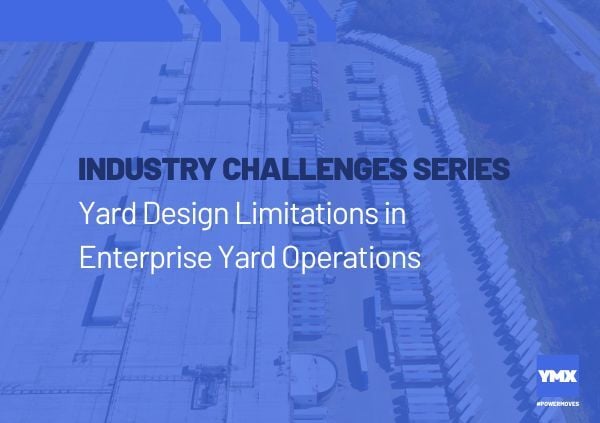For years, yard operations have been treated as the forgotten link of the supply chain—an overlooked and chaotic space between transportation and warehousing. While distribution centers adopted automation and transportation networks were transformed by TMS platforms, yard operations remained largely manual, reactive, and disconnected.
As highlighted in the recent Enterprise Yard Operations as a Strategy webinar hosted by YMX Logistics, that mindset is changing rapidly. Moderated by Bart De Muynck (former VP of Research, Gartner) and featuring Rick McDonald (former CSCO, The Clorox Company), Scott DeGroot (former VP of Global Planning & Logistics, Kimberly-Clark), and Matt Yearling (CEO, YMX Logistics), the panel delivered a clear message:
Yard operations are no longer a tactical necessity—they are a strategic lever for efficiency, resilience, and sustainability.
Why Yard Operations Matter—Now More Than Ever
Consumer goods and manufacturing supply chains are being re-engineered from end to end. Network design, inventory strategy, and transportation models are all evolving to support nearshoring, automation, and faster delivery expectations. Companies can no longer optimize just inside the four walls; they must connect every operational node, including yard operations.
As McDonald explained, “All of us have to operate at the speed of the consumer.” Modern supply chains move faster and tolerate less slack. That means a delayed check-in, misplaced trailer, or inefficient move can cascade across the entire network.
DeGroot emphasized the hidden impact:
“We’ve engineered standards for every movement inside the warehouse, down to the second—but none for yard operations. We wouldn’t accept a five-minute delay on a production line, yet we tolerate it outside the dock door every day.”
Those minutes, multiplied across hundreds of trailers and dozens of facilities, add up to millions in lost productivity and unnecessary cost.
The Limitations of Legacy Models
According to Yearling, traditional approaches to yard operations have failed to evolve with the rest of the supply chain. About half of enterprise operations are still insourced, often relying on untrained labor or fragmented oversight. The other half is outsourced to 3PLs that treat the yard as an extension of warehouse contracts or providers that are only interested in maximizing the number of trucks and man-hours sold rather than a core competency.
Meanwhile, the technology market has splintered. A wave of point-solution Yard Management Systems (YMS) promised visibility but rarely delivered measurable outcomes. “More than half of YMS deployments don’t generate real value,” Yearling noted. “They’re isolated tools solving narrow problems rather than improving the operation as a whole.”
The result is operational inconsistency, minimal accountability, and limited integration across transportation, warehousing, and corporate systems.
Why It’s Strategic—Not Just Operational
When yard operations are optimized, every upstream and downstream function benefits.
- Customer Experience: Faster trailer turns and fewer detention events reduce OTIF penalties and improve carrier satisfaction. “Carriers keep score,” McDonald warned. “If your yard operations create delays, you’ll pay higher rates or lose capacity.”
- Financial Impact: DeGroot estimated that CPG companies can unlock $5 million to $30 million annually by applying the same rigor used in manufacturing to yard operations.
- Sustainability: Electrified yard trucks and optimized moves reduce fuel consumption and CO₂ emissions while improving driver experience.
Technology Alone Won’t Fix It
Every panelist agreed that technology, while essential, is not the full answer. Many digital initiatives fail because organizations deploy tools without the change management and workforce alignment required for adoption.
McDonald shared an example from Clorox: after rolling out a leading planning system, his team reverted to spreadsheets because the company hadn’t invested in upskilling or user confidence. “We had to pry the spreadsheets out of their hands,” he said.
DeGroot added, “Eighty percent of companies don’t capture the full value of digital transformation because they fail to marry the human and technical elements.”
Yearling summarized it succinctly:
“Start with the outcomes you want to achieve, then work backward to the right mix of people, process, and technology.”
The Alternative: Yard Operating Systems
YMX Logistics introduced the Yard Operating System (YOS) as a modern blueprint for optimizing and integrating yard operations across the enterprise.
Yearling adds:
“True transformation happens when manufacturers orchestrate every yard activity with intent—aligning metrics, labor, equipment, processes, sustainability, safety, technology and data to achieve operational excellence at the facility level and across their networks. Yard operations represent an immense untapped opportunity waiting to be unlocked.”
From Risk to ROI
Neglecting yard operations introduces measurable risk—delays, safety incidents, detention costs, and lost throughput. Yet unlike warehouse automation or network redesigns, optimizing yard operations requires minimal disruption.
“Be curious,” Yearling advised. “Let someone analyze your toughest site. We can transition in a single day and deliver an immediate performance upgrade without increasing cost.”
The opportunity is clear: minimal risk, rapid deployment, and rapid ROI. As DeGroot put it, “Shake off the apathy. If you don’t know your yard operations performance, find out—you’re spending millions and leaving value on the table.”
The Future of Yard Operations
Automation, electrification, and AI will continue to redefine the landscape, but the technology already exists to achieve transformative gains today. The real change begins with mindset—recognizing that yard operations are a controllable, optimizable, and strategic component of the enterprise supply chain.
McDonald concluded with a call to action:
“If yard operations aren’t part of your operations strategy, they need to be—quickly. Competing at the speed of the consumer requires a connected, visible, real-time supply chain. Yard operations are part of that connection.”
The era of reactive, fragmented yard management is coming to an end. With more sophisticated providers emerging to manage yard operations as an integrated system, leveraging Yard Operating Systems to reinforce standards, maximize performance and sustainability gains. Enterprise shippers are now beginning to shift from ad-hoc control to structured orchestration. The result is a move away from daily firefighting toward a disciplined, data-driven approach that turns yard operations into a consistent source of reliability and strategic value for the entire organization.

%20(19).png)
%20(10).jpeg)
%20(7).png)
